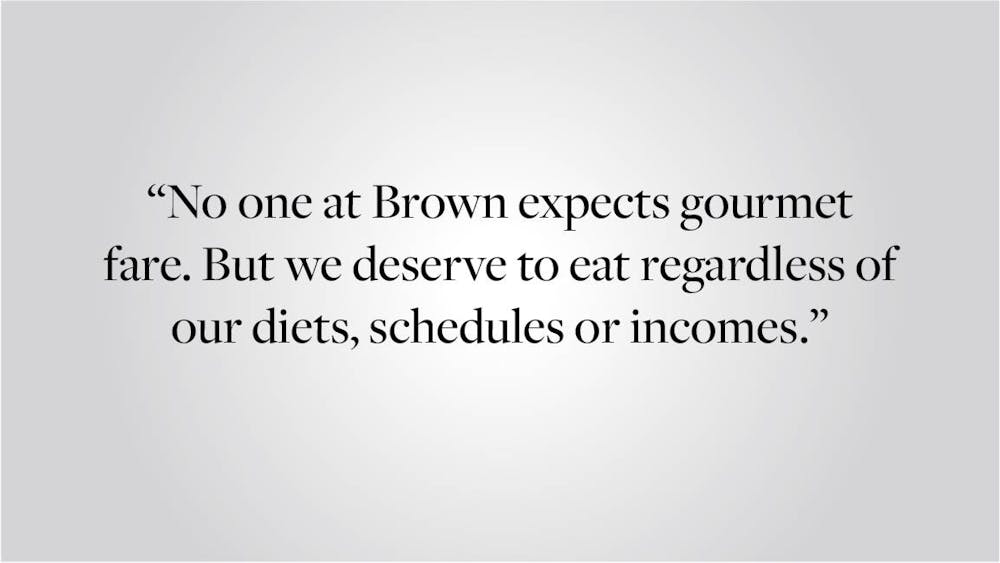With students once again flooding into the Ratty, clamoring for sandwiches at the Blue Room and foraging for a late-night snack at Jo’s, Brown dining is back — but for many, it is not back to where it needs to be.
Shorter hours, fewer dining options, longer lines and steadily increasing prices have made it difficult for students to access meals during their busy days. No one at Brown expects gourmet fare. But we deserve to eat regardless of our diets, schedules or incomes — and better-tasting food wouldn’t hurt as well.
Brown claims that it cares about food security, but the absurd wait times plaguing dining halls are just one of many symptoms that suggest otherwise. Lines at campus eateries during the midday rush can eat up over half an hour of many students’ lunch breaks. Some opt to skip meals altogether, rather than wait in line between classes, while others who can afford it choose to order food on Thayer Street, an option that is not available to everyone. Why should convenient and high-quality meals only be available to those with extra disposable income?
Jessie Curran, director of wellness and nutrition, has suggested that the long lines will settle down as the semester progresses. But almost one month into the semester, we are still regularly greeted by a line of students stretching out the V-Dub doors. And upper-classmen have noted how the current lines are unlike any they’ve seen in years prior.
Brown has made some efforts to make mealtimes more efficient, such as introducing a grab-and-go option at certain dining halls. But this solution feels like a flimsy bandage for bigger problems.
One of these problems is the inconvenient operating hours of our dining halls. The Ratty, the main dining hall on campus and the most centrally located, closes at 7:30 each night, which sometimes clashes with busy college schedules. If students need to grab a late-night dinner, one of the only options is Jo’s, which features fewer healthy options. And on the weekends, students are largely limited to the Ratty and Andrews for daytime dining. At best, dining hall hours are inconvenient. At worst, they cause students to skip meals entirely.
Brown has also found other creative ways to restrict the dining experience for students. For example, the Blue Room, formerly a go-to spot for students looking to grab a quick breakfast or a hearty sandwich, is no longer accepting meal plan points as a payment method. Instead, students must use cash, credit cards or Bear Bucks, effectively turning the Blue Room into a pricey cafe rather than a convenient dining hall available to all students. The new policy only exacerbates existing inequities by making the food there accessible only to students with extra money to spend. It also explains why our dining halls are more crowded, since the University has reduced our dining options, despite having more students to feed than before.
Brown Dining’s issues with accessibility run deeper than just the operating hours or payment options. The food itself has problems. Students have a wide range of dietary needs and preferences, and although Brown Dining Services attempts to accommodate them, current dining options fall short for many. Some have noted limited vegan and vegetarian options repeated at near unbearable frequency. The Ivy Room, once a reliable provider of tasty vegetarian options (such as the popular “naan-wich”) has modified its menu to the detriment of many students. And online menus are often inaccurate or incomplete, leaving students guessing at what might be available if they trek to a dining hall across campus.
We aren’t asking for luxury, and we aren’t critiquing the hard-working staff at our dining halls — we are asking for decent food, decent variety and decent accessibility. As both first-years and sophomores are required to be on a meal plan, choosing to eat at a Brown dining hall is not a choice for many. Meal plans are also expensive and continually getting pricier. If Brown has a monopoly on our meals, they are obligated to provide convenient, healthy meals to students each day.
Brown Dining has never been and never will be perfect, but we know that it can be better. The University must make a commitment to a better dining experience — whether by creating more dining options, expanding hours or improving the variety of food available to students. Some seasoning wouldn’t hurt either.
—Editorials are written by The Herald’s editorial page board. This editorial was written by its editor Johnny Ren ’23, and members Clara Gutman Argemí ’22, Catherine Healy ’22, Olivia Burdette ’22, Devan Paul ’24 and Kate Waisel ’24.





